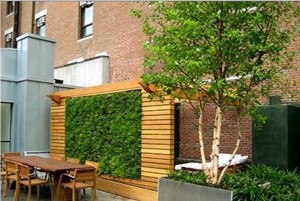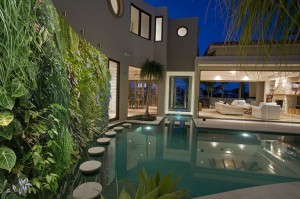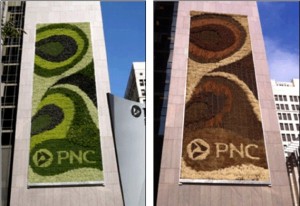
Garden Up with Green Walls
Green walls, vertical gardens or living walls are gaining popularity both inside and out and I love the idea. Like most ideas, it isn’t exactly a new one. The practice of planting ivy to climb up the walls of buildings has existed for centuries. The new vertical gardens are simply a natural extension of this concept. So far, they seem to be predominantly cropping up in city environments, but we predict you’ll see more and more of this trend spreading to the ‘burbs.
Vertical gardens offer a number of benefits. The most obvious is aesthetics; they can make structures more attractive and add fragrance. They can create an inviting habitat for urban wildlife. They also help absorb sound and improve air quality indoors and out. Green walls decrease CO2 and increase humidity. (Although how much they improve air quality is a pretty hotly debated topic – as are some of the other pros versus cons of green walls.)
Other positive claims: exterior green walls reduce solar gain (the increase in temperature in a structure that results from solar radiation) thus lowering energy costs, they provide protection from the effects of UV radiation and acid rain, and help lessen the building’s contribution to the heat island effect (when natural areas are replaced with concrete and asphalt, they become warmer).
So what are the potential negatives to green walls? The biggest concerns fall into three general categories: 1) over-inflated claims regarding the benefits (don’t expect to save 20% on your energy bills!), 2) the debatable trade-offs that relate to sustainability – for example, a number of the grid planter systems on the market are made of plastic, and 3) the long-term sustainability of the walls.
Of these, the third is not something you read or hear a lot about, but it is perhaps the most important. While properly constructing and installing a green wall or green panel (after all, green walls don’t need to be an entire wall) isn’t exactly a cakewalk, maintaining a green wall is the bigger challenge. If many or all of the plants need to be replaced frequently one has to question the sustainability.
The reality is, to successfully maintain a green wall on anything but the smallest of scales is best left to experts. It requires an in-depth knowledge of design, irrigation, plants, growth media, pest and disease management and fertilizers. Choosing the right system, the correct plants for the setting and understanding the science behind the technology are all keys to green wall’s longevity.
As I said at the beginning of this post, I love the idea of green walls and vertical gardens. I’ve seen lots of striking examples, the most dramatic being some of the commercial applications. (Although personally I also love the small, less ambitious and more maintainable residential efforts.) The key, as with any landscaping effort, is in getting all the variables right for sustainability.


